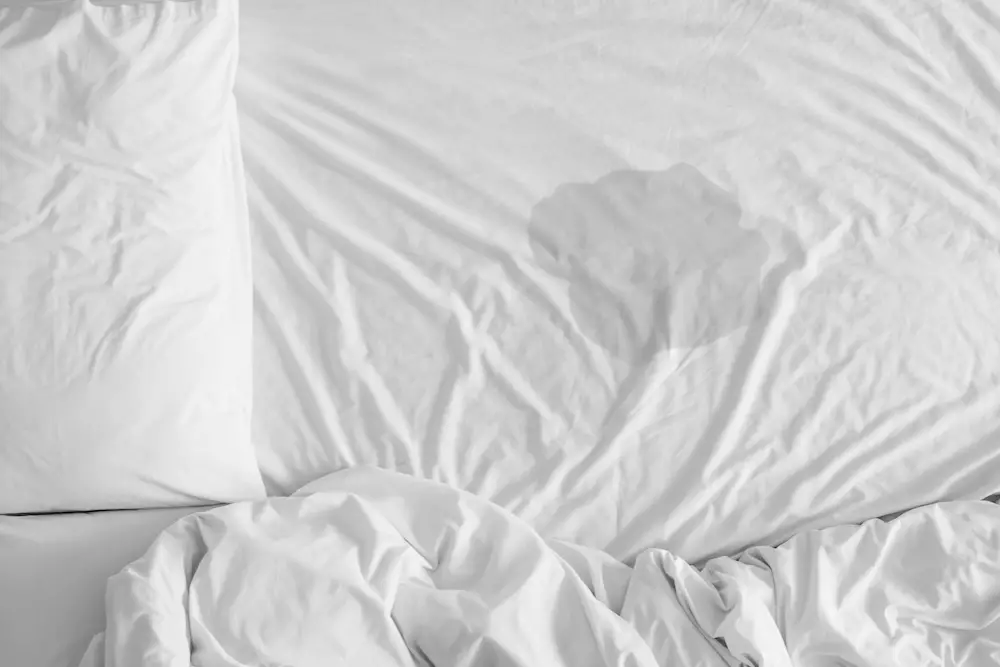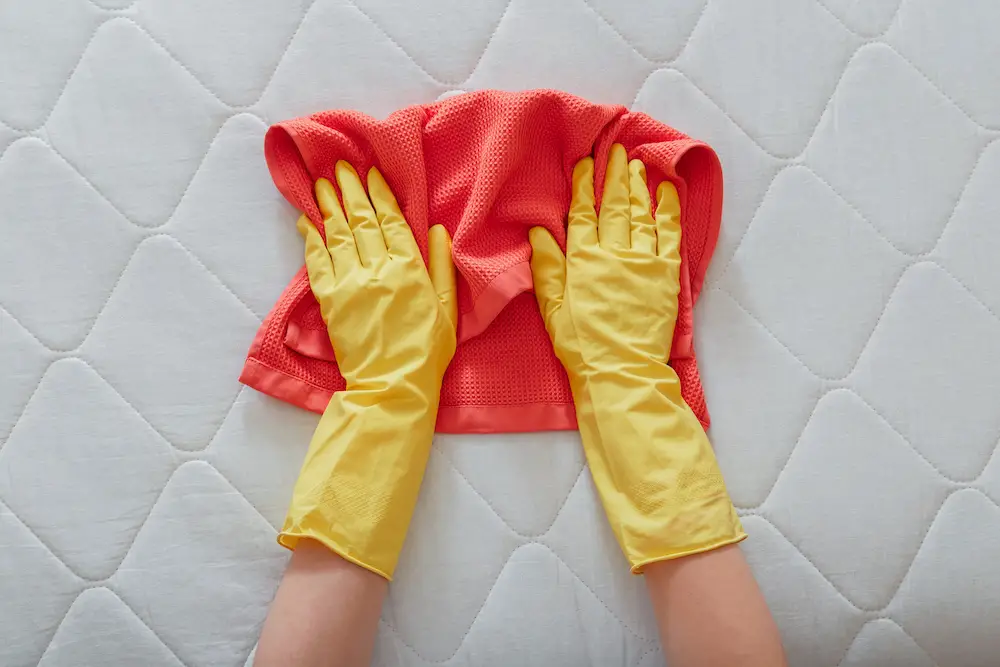That dreadful feeling when we realize there’s been an accident on the bed is well-known to us all.
Whether it’s an unwanted surprise from sleeping next to your dog or a bed-wetting accident with your child, it’s just a cumbersome matter to deal with.
This is where knowing how to get pee out of memory foam mattresses will come in handy.
Regardless of the origins, you just have to accept that accidents come with the territory when living with toddlers and pets.
About Memory Foam Mattress
Before we jump into removing urine on a memory foam mattress, let’s first understand what this material is and its qualities.
Memory foam has made its way into one of the staple materials in American households and around the world.
It primarily consists of polyurethane foam, which is infused with chemicals to improve density and viscosity.
In memory foam terms, viscosity is a characteristic that makes the material resistant to changing form under pressure.
Memory foam works by containing the pressure applied against it while gently springing back to form.
Before it became a popular mattress material to the general public, memory foam was a common element in sports helmets.
It helps deliver relaxation and support on the wearers’ heads, which is conducive for different types of strenuous activities.
Hospital beds are also a typical application of memory foam, as it aids in reducing issues such as bed sores and gangrene for bed-ridden patients.
Advantages of Memory Foam Mattress
Listed below are a few notable reasons why many choose a memory foam mattress over other variants.
- Durability
As far as mattress lifespans go, memory foam is among the longest-lasting in the market.
Well-maintained, premium memory foam mattresses could last decades.
In comparison, spring mattresses are usually fully functional for about five or six years.
Memory foam mattresses may last up to three times more than that.
One of the reasons for their longevity is that they don’t have any springs that eventually wear out.
- Comfort and Support
Due to its ability to fill gaps throughout the body, memory foam mattresses offer comfort and support, regardless of your sleeping position.
It provides waist support for side sleepers while reducing pressure on the shoulders and hips as well.
For stomach sleepers, it will preserve the natural curve of your spine and prevent pressure on your back.
To provide ideal spinal alignment and tailored support, memory foam conforms to the shape of your body.
As a result, it will feel as if it was custom-made because of the personalized comfort it offers.
- Motion Transfer-Resistant
If you are frequently awakened by your partner constantly tossing and turning during sleep, opting for a memory foam mattress is ideal.
The material absorbs pressure and movement, effectively minimizing the disturbances you or your partner makes.
- Hypoallergenic
Polyurethane foam has a thick fiber structure resistant to typical allergens like mildew, mold, pet dander, and dust mites.
Therefore, memory foam mattresses help reduce allergy flare-ups or other allergy-related symptoms.
As you can imagine, allergy symptoms, such as nasal drip, can make it difficult for people to sleep.
A memory foam mattress may be your only choice if you have trouble sleeping at night due to your allergies.

What Happens If You Don’t Remove Pee from Memory Foam?
Maintaining your memory foam mattress could be a tedious task. However, there are issues you’ll encounter if you choose not to.
Here are possible issues you may have from constant exposure to urine.
Proliferation of Mold
Continuous incidents of bed-wetting usually result in a damp memory foam mattress.
If you don’t properly clean and dry your bed, mold will start to accumulate, even if memory foam has high resistance to it.
Inhaling or contacting mold spores can trigger allergic responses.
For mold-sensitive individuals, these may include anything from sneezing and sore eyes to skin rash and runny nose.
In severe cases, shortness of breath could also happen.
Asthmatics who are sensitive to mold might have asthma episodes if they inhale or make contact with mold spores.
Even for persons not allergic to mold, constant exposure could lead to irritations on different parts of the body.
Once an infestation of mold is evident on your memory foam mattress, the recommended action is an immediate replacement.
Bed Bug Infestation
Urine contains histamine, a chemical generated by white blood cells to defend the body against a possible allergen.
According to research, bed bugs are drawn to histamine, which is also a substance they manufacture themselves.
In case you don’t know, a couple of bed bugs now can turn into a full-blown infestation of 13,000 or more within six months.
While bed bugs are not necessarily disease carriers, they can still give you trouble.
Their presence may lead to itching, loss of sleep, or an allergic reaction.
In certain situations, the lingering itchiness could cause aggressive scratching that could lead to a skin infection.
Foul Odor
Urine is known to have a pungent smell and could linger on your memory foam mattress if you leave it uncleaned.
The smell is caused by the amount and concentration of waste materials produced by the kidneys.
Urine with a high concentration of waste products and little water may smell strongly of ammonia.
Unfortunately, respiratory issues and allergies could be the result if you let yourself inhale ammonia regularly.
Stench removal is arguably the most challenging part of cleaning your mattress, especially once the smell is widespread.
How To Get Pee Out of Memory Foam Mattresses?
Now that you know memory foam mattress is a boon in your sleep, there’s no other motivation needed to clean and maintain it regularly.
Let’s enumerate the steps you need to do to remove urine from your memory foam mattress.
Step 1: Remove the Bedding
Before anything else, remove the beddings and toss them in the washing machine as soon as possible.
You’ll need to do this as soon as you notice the urine to avoid stains.
Step 2: Prepare Supplies
After you strip the memory foam mattress, gather the items below to get started:
- Dry towels or tissue paper
- White vinegar
- Spray bottle
- Baking soda
- Dishwashing liquid
- Vacuum cleaner
- Enzyme cleaner (optional)
- Air freshener spray (optional)
Step 3: Blot the Affected Areas
Blot the mattress with a towel or tissue paper and leave it to absorb as much pee as possible.
Avoid rubbing because the stain will just become worse.
Once the towel or tissue is not absorbing anything, it’s time to spread white vinegar on the surface of the affected areas.
Use as much vinegar as you see fit.
Then, let the vinegar stay for a couple of minutes, and then use fresh dry towels to blot out the vinegar.
This is where you should take your time and be as thorough as possible.
Step 4: Apply the Solution
Grab the spray bottle and get started to create a homemade urine remover.
Prepare about a cup of hydrogen peroxide, three teaspoons of baking soda, and a few drops of dishwashing liquid.
Put them all in the spray bottle and shake it gently.
Avoid shaking the bottle aggressively; swishing it around should do the trick.
Then, spray the solution on the areas affected and let it sit for 15 to 20 minutes to absorb the urine.
After that, use a fresh towel or tissue to blot the solution.
You might need to repeat the application and blot a couple of times to effectively remove the urine stain and odor from your memory foam mattress.
An enzyme cleaner may be needed if the urine has an extremely pungent smell or if it’s from a pet.
This cleaning product breaks down the crystals of uric acid in the pee, which neutralizes lingering odors.
Step 5: Sprinkle the Baking Soda
Remove residual odor and moisture by peppering the affected areas with a generous amount of baking soda.
It would be best if you then let it sit on the surface for a couple of hours to eliminate any lingering smell.
Step 6: Use the Vacuum
Grab your vacuum cleaner with an upholstery tool attachment to clean out the baking soda you applied to the mattress.
Once the memory foam mattress is entirely free of any residual powder, the process is complete.
A Quick Reminder
Although your mattress may appear to be dry from the exterior after cleaning it, it may still be damp inside.
It is preferable to over-dry it than to leave it moist and let it dry naturally.
After all, moisture can lead to some unwanted growth that could ultimately shorten the service life of your memory foam mattress.
Final Thoughts
Given the benefits of knowing how to get pee out of memory foam mattresses, it’s essential to ensure that you do it properly.
Even so, the cliche saying “prevention is better than cure” is also applicable here.
A mattress protector can save you the hassle of tedious cleaning while also prolonging the service life of your memory foam mattress.
Choosing a high-quality, water-resistant bed protector will help protect your memory foam mattress from a number of deterrents, including urine.

